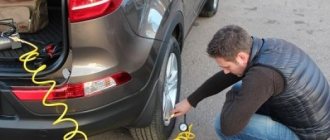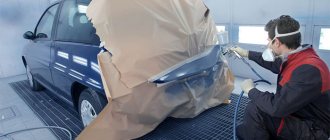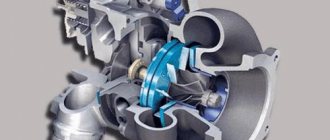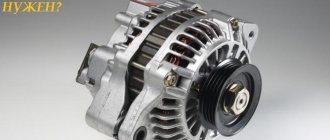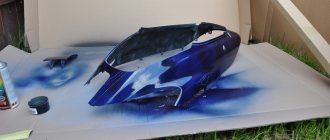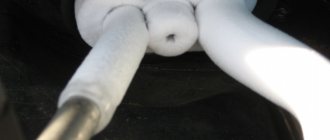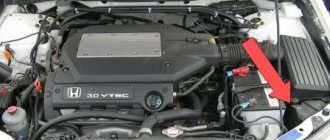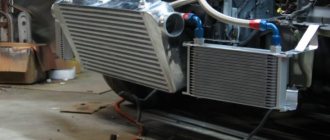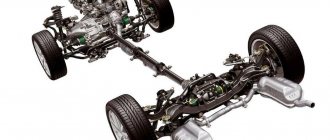Today, the market offers a very wide selection of different compressors for painting cars. There are both domestic and foreign compressors. The correct choice of model determines the quality of painting and ease of use, so it is important not to make a mistake when choosing. This article is about how to choose a compressor for painting a car.
old compressor
All devices differ in many respects in their technical characteristics, so you need to buy a compressor that suits the specific type of repair work that you are going to do.
Let's name the main criteria by which it is customary to divide compressors for painting:
- internal device (piston or screw);
- criterion for the presence of oil (oil or oil-free);
- transmission method (direct drive or belt);
- type of power source (220 or 380 V network or diesel);
- receiver volume;
- air injection force;
- permeability of compressed air flows.
Let's look at the two main types of compressor devices.
Screw compressors
Screw compressors implement the principle of joint rotation of rotors, which are located parallel in the compressor housing. As these rotors rotate, small cells are dynamically created, the volume of which decreases as the screw unwinds. This creates increased pressure at the outlet.
Note that such compressors are necessarily equipped with control and monitoring protection systems, and this allows you to quickly adjust the limit values of their operation. Fine tuning allows for a stable supply of compressed air over a long period of time.
A screw compressor for painting cars, meanwhile, is an expensive option. However, it is also more technologically advanced than its piston counterpart. Such devices are reliable and durable, and if you actively use them, the compressor will pay for its cost. Most often, of course, such compressors are installed in enterprises where uninterrupted operation around the clock is required.
Another advantage of the screw design is its low energy consumption. Compared to other types of compressors, screw compressors save up to 30% of electricity. In addition, they make extremely little noise during operation. This has a positive effect on the quality of the painting.
If you don’t just need to buy a compressor for painting a car for show, but also need to ensure high quality, rely on the screw model. At the output, such a compressor produces high-quality air flow with a minimum of oil and water.
The dimensions of the screw compressor allow it to be placed on a very limited base: this way you will save a lot of space. Let us emphasize once again the high cost of a screw compressor, but it is worth it. Especially if you are the owner of your own business and you need to expand your business.
Typically, the power of such units ranges from 2.2 to 5.5 kW. Productivity can reach 620 liters per minute at a pressure of ten atmospheres. The model you choose will probably come with a set of filters and refrigerated dryers that can be mounted on the air intake.
With proper competence, you can do this yourself or invite specially trained craftsmen.
Which compressor to choose for car painting
Buying a compressor is an important point; having purchased a quality product, a person will be able to independently service his car. The problem is that Russian and foreign markets offer a huge range of devices. The question arises, which compressor to choose for painting a car? The quality of painting of a vehicle or other installation depends on the successful choice of model. All devices have different technical characteristics, for this reason it is worth going through all the indicators and requirements that arise when working with the mechanism.
Car painting process
Purpose of the compressor
A compressor is a universal unit that supplies air and gas under pressure. During painting, the compressor prepares the compressed mixture for the next step. Devices with a shallow chamber and low pressure do not cope with the task properly - smudges and unevenness remain. Most often, weak compressors are used to inflate wheels. If the compressor is powerful, then the range of its capabilities expands significantly. The installation copes with such tasks as:
- car painting;
- working with pneumatic tools - impact wrenches, car diagnostic devices and inflating tires;
- applying a primer during car repairs;
- used as a sprayer of anti-corrosion agents;
- cleaning mechanical components, blowing out parts, and removing dirt from the hose during maintenance
- vehicle;
- car washing and polishing.
Types of structures
Let us outline the criteria by which it is customary to classify a compressor for painting a car:
- Piston devices are convenient and reliable, but if they are weak according to the criteria, then painting the car will not be effective. Compressors of this type are more suitable for masking peeling paint. Its advantages are low cost and easy replacement of broken parts. You can update most of the elements without disassembling the case. In addition, energy saving is an important characteristic. The essence of the compressor operation is based on the activity of an electric and diesel drive, where electricity is converted into the energy of a compressed air mixture. The energy then flows through the tube, driving the compressor.
- The screw-type assembly is used to apply a paint layer to the body of vehicles. Installation and use of this type of device is simple and operation is economical. The process of squeezing air in the system is based on the simultaneous scrolling of gates standing parallel in the body of the device. Afterwards, compartments appear, slowly decreasing and creating high gas pressure. This type of compressor has an automatic control protection system - this provides an uninterrupted air supply, allowing the worker to instantly set the required mode in difficult conditions. Such devices are used in large enterprises where long-term and uninterrupted operation is required.
- Oil-free and other devices that pump clean air are not suitable for pneumatic delivery of jets to the body, since the pressure contains a lot of hydrogen, which leaves bubbles in the applied layer of paint.
- Turbine machines for supplying compressed air are ideal for painting. The device is highly productive, but is not suitable for mobility and control.
- Combined oil-piston compressors are well suited for painting; they perform the job without flaws and are very compact in design.
Compressor
Compressor for painting machine
First of all, in order to understand what type of compressor is needed for painting a car, you should know the list of its technical characteristics; we will consider them below. If you plan to use a compressor to remove minor scratches, then a device with low power and a small tank volume is quite suitable. It will not be possible to produce an even layer with imperceptible transitions. Also, the presence of a compressor requires the purchase of a spray gun. The choice of sprayer is quite extensive. You need to decide at what professional level you are going to work - to mask small flaws or to do high-quality painting of the entire car.
Types of spray guns
A spray gun is a device that sprays paint. There are 7 types differing from each other in the mixture dispersion system. The most popular of them:
- HVLP - low pressure but high volume. Apply paint outside the object being painted in small quantities. The disadvantage is that HVLP only works with powerful compressors pulling at least 360 liters of air per minute. In addition, the engine runs in high mode - this consumes a lot of oil, which implies the presence of additional filters;
- HP - high pressure. HP sprayers have many advantages, but the downside is that excess paint goes outside the object in large quantities. A turbulence is created in the air, and the raised dirt lands on the object being painted;
- LVLP - low volume and low pressure. The good thing about the system is that there is low pressure when entering and exiting the nozzle. Excess paint yield is low and does not require a powerful compressor.
Compressor selection
When you buy a compressor separately from a spray gun, you should rely solely on the values of the spray gun. Those who do not understand this can buy a ready-made kit. The first step when choosing is to check with a consultant about the performance of the device. Capacity is the volume of air coming out. For example, 100 liters of air enter the receiver, and after compression the performance is 65. When the kit is assembled incorrectly, the operation will not last long, and the warranty does not apply to this. When choosing, we focus on the following values:
- HVLP requires a compressor up to 360-515 l/min. The required pressure is 2.5-3 inlet, 0.7 outlet;
- For HP we take a compressor with a capacity of up to 300 liters per minute. Pressure 5 atmospheres at the inlet and 1.5 at the outlet;
- LVLP - 150-350 l/min.
The inlet pressure is 2, and the outlet pressure is 0.7-1.2 atmospheres. Spray gun before assembly
The technical data specified in the unit’s passport often does not coincide with the actual data. The values given indicate theoretical performance and power only, based on cylinder and piston volume. In fact, the power is often half of these values.
Please note: inexpensive compressors for painting work can be purchased from this company.
Criteria for selecting compressor models for car painting
Which model to buy depends only on your plans; let’s look at some of the options:
- If you are not thinking of professionally painting your vehicle, then for rare use a single-cylinder oil piston device with an inlet pressure of 8-10 bar and a receiver volume of 50-100 liters is appropriate. It will produce about 330 hp. on receiving air and 215 liters in 60 seconds on output. They won't be able to paint the entire car, but they can disguise scratches.
- Those who plan to get seriously interested in painting need a screw mechanism with a 200 liter receiver, 10 atmospheres and a capacity of 515 liters. in a minute.
- Smart beginners will find it useful to have a single-cylinder piston-type compressor with oil filling, a pressure of 10 atmospheres and a 100-liter receiver with a set of 330 l/m. They can do small jobs, but the compressor is not suitable for completely painting the car, since it is not able to take the required amount of air.
- For complete painting of cars, a good option would be an oil belt compressor with a 200 liter receiver, a capacity of 515 l/m and a pressure of 10 atm. The device works for a long time and is capable of repainting heavy equipment. The price of the device is appropriate.
- Installation for a pro. For those who have been painting cars for a long time, purchasing a low-power screw device (capacity 240–620 l/m, pressure 10 atmospheres) would be an ideal solution. The high price soon pays off, and cheap analogues that are inferior in power are not capable of performing such high-quality painting.
Regardless of what functionality you decide to purchase a compressor with, remember that high-quality maintenance of the purchased equipment comes first.
ktonaavto.ru
Piston compressors
Piston compressors, despite the listed advantages of screw ones, are even more popular. Piston compressors are available in oil and oil-free types. These are very simple and reliable devices and, importantly, they do not require professional maintenance.
piston compressor
Piston compressors are usually used for basic tasks: inflating tires, painting buildings. But if you are looking for an answer to the question of what kind of compressor is needed to paint a car, you can answer it with some degree of certainty - not a piston one.
More precisely, not an oil-free piston. Unless, of course, you want high-quality painting. However, oil-free piston engines are the cheapest option that can be found in the store.
However, oil compressors with a piston can provide some competition to their screw counterparts. They are united by the fact that oil is poured into their working environment. These devices are traditionally equipped with direct or belt drive.
In turn, belts are divided into two types - single-stage and two-stage. The latter do not make so much noise during operation, and are also more efficient. Therefore, in the race of the main competitors, we will highlight two types: piston oil two-stage compressors and electric screw industrial units.
Please note that there are designs such as tandem compressors. A compressor for painting a car must have some constant pressure, and this design successfully provides this property.
A tandem compressor consists of two separate piston compressors that feed a single receiver. They, of course, have high power and are used for critical tasks.
If we touch on this type of compressor, such as a belt-driven piston compressor, we note that it is quite reliable, although this depends on the features of its design. The belt drive runs from the engine to the flywheel of the compressor head. Compared to compressors equipped with direct drive, belt drives have a number of advantages:
- in an engine, the diameter of the pulley is much smaller than the diameter of the flywheel;
- lower engine speed required;
- good airflow to moving parts during operation.
- Car painting and facade work
Types of construction
The air injection device is similar to an internal combustion engine, in which, using a piston, air is pumped and redirected into the receiver. But instead of the energy of expanding gases released during the combustion of the fuel-air mixture, the piston receives its movement from an electric motor. The design also contains: a lubrication system, automation, a fan, an intake air filter, a drain valve and a device for regulating the outlet air pressure. In a global sense, all piston compressors that can now be chosen for home use are divided into two types:
- with belt drive. The electric motor shaft is connected to the crankshaft through a belt drive;
- with direct drive. In this case, the crankshaft and the rotor shaft of the electric motor are articulated, which provides direct transmission of torque.
In turn, direct drive piston superchargers are divided into oil and oil-free. Which one is better to choose? It is clear that an oil compressor is more preferable for painting and car repairs. With comparable engine powers, the performance of such superchargers has very minor differences (often in favor of the option with an oil system). In addition, oil-free compressors do not require periodic lubrication, can be transported in any position, and do not require a flat surface for operation. It's all about resource and reliability. Oil-free compressors are always quite low-power, so even with element-by-element painting they will have to work almost constantly. This mode not only significantly reduces the service life, but can also cause overheating and rapid breakdown. In an oil supercharger, some of the heat can be removed through the lubricant, and the wear of rubbing pairs is also significantly reduced. Alas, you won’t be able to paint your car with an oil-free air blower.
Which one is better?
You can start choosing a compressor for painting a car with the following options:
- single-piston, direct drive, 24 l receiver and power up to 2 kW. Such a unit is suitable not only for local painting, but also for treating the underbody of a car with anti-corrosion properties, covering arches with liquid sound insulation, and sills with anti-gravel. The productivity of such compressors is about 200 l/m. The option with a 50 liter receiver is more preferable;
- two-piston with a receiver of at least 50 liters and a power of 2 kW. Peak engine speeds with a direct drive can reach 2850 rpm, while a belt drive, due to the ratio of the diameters of the pulleys, allows you to keep no more than 1200 rpm. In practice, this difference results in less heating and a longer service life. Belt-driven blowers are also easier to start in cold weather. There is not much difference in the rate of pressure build-up. The productivity of such units starts from 300 l/min. You can make additional receivers yourself, which will allow you not only to completely paint the car, but also to use professional pneumatic tools in the slightest degree.
Three-piston compressors, as well as superchargers with an electric motor power of more than 3 kW, due to their high cost, can be recommended for purchase only as professional equipment for service stations.
It turns out that to paint a car in the garage, you can choose a two-piston compressor with a 50 liter receiver. If you have the funds, of course, it is better to buy a unit with a belt drive, as it will last much longer.
Correct performance calculation
Manufacturers use a trick, indicating in the characteristics not the actual amount of air pushed out by the pistons per minute, but the amount of air sucked in. Therefore, real performance indicators should be reduced by 20-25%. At the same time, manufacturers of pneumatic tools (especially cheap brands) sin by indicating in the characteristics an underestimated amount of air consumed. Therefore, it is desirable that the recalculated compressor performance parameters exceed the theoretical consumption of pneumatic tools by at least 5-10%. The actual utilization rate of, for example, a spray gun is approximately 0.7. If the passport specifications indicate a consumption of 300 l/min, then in fact 200-210 l/min will be used in operation. Therefore, such a gap will be quite enough for comfortable work.
The compressor is the last thing to choose.
This is exactly what the most important rule for choosing a compressor for painting a car sounds like. If you buy a weak compressor, then later, if you wish, you will not be able to use a pneumatic orbital machine or HVLP spray guns, which are very power-hungry. Even with a small painting area, you will have to take breaks to accumulate the required volume of air. In such conditions, painting turns into a real torture, which, of course, can affect the quality of the work.
That is why, before buying a compressor for painting cars, you need to know approximately the volumes that you will paint, as well as the amount of air consumed by the pneumatic tool. When we talk about volume, we're not talking about the frequency of painting jobs so much as the number of parts you plan to paint at one time. Take on full car painting with a compressor with a capacity of less than 270 l/min. and a receiver with a volume of less than 50 liters means you are obviously dooming yourself to difficulties. Even with the most economical LVLP spray gun, the compressor will run constantly, causing overheating and significantly reduced service life.
How to choose a compressor for different types of work
If you paint cars or paint exteriors, you'll need a compressor that can handle heavy workloads. Before buying a compressor, choose a spray gun - this is your main working tool.
And then, depending on the requirements specified in the technical regulations of the spray gun, you must choose a compressor. If you choose a piston compressor, it should have at least 15 percent of the power reserve required by the spray gun. Painting different objects, in addition, requires a different approach to the quality of painting, this should also be taken into account.
- Periodic simple painting work. To successfully carry out occasional car painting jobs, you can purchase an oil-injected piston compressor, which would have a capacity ranging from 130 to 250 liters per minute. But this range should not be less than the volume of air consumed by the spray gun. The pressure, in addition, should not exceed ten atmospheres, and the power should not exceed 3 kW. For such a model, it makes sense to buy a dehumidifier for the compressor, as well as a refrigerated dryer, so that the outgoing paint does not contain impurities. Filters will separate oil and water vapors and also trap larger particles. If you want the best quality paint finish, be sure to upgrade your compressor like this.
- Professional painting work. If you expect to carry out painting work at a professional level, you may need additional advice from specialists in this field. It is necessary to take into account energy consumption, power, and amount of work. Do not be deceived by the seemingly low cost, since in your situation you will have to carry out constant emergency or preventative repairs, which require costs. And the loss of product quality is a blow to your reputation as a craftsman, and therefore to your profit.
Listen to this recommendation: if you bought a piston model that you want to use to the maximum, be sure to install a dehumidifier on it, since this is due to high volumes of work and requirements for increased quality of the finished product.
Or, to avoid possible problems with a piston compressor, it is better to buy a screw compressor for painting. It should have low power, which should be enough for the constant operation of one spray gun.
Tips for choosing both types of compressors
Choosing a car compressor requires an accurate calculation of pressure, which is usually neglected. The pressure varies between models. Keep in mind that in piston models you need to maintain a constant pressure in a narrow range from 6.5 to 7 bar.
If these conditions are met, you may not need to purchase a screw version, which pumps air with a force of 10 bar. If your installation increases the pressure by at least one bar, then it will immediately begin to consume 8% more electricity.
compressor pressure gauge
Thus, a correctly selected and configured compressor will save on electricity, and in terms of reducing production costs, this is important. When making preliminary calculations, keep in mind that the path along which the air passes from the point of creation of the high-pressure area to the exit point does not ensure stable tightness, especially in conductive tubes, dryers, filters, so you should always make small adjustments to the power in a positive direction.
Then you will be satisfied with the quality of pressure, and therefore the quality of painting.
Compressor selection options
Pressure
Pressure shows the force of air compression: it is measured in “bars” (1 bar ≈ 0.99 atm). Knowing this value for the unit, you can determine the degree of interaction with the desired tool.
For example, a paint sprayer requires about 6 bar. You should always choose with a small margin, since as consumption progresses, the pressure may drop by several points.
Performance
Productivity is an indicator that determines the volume of air (gas) that is compressed per unit time. Usually measured in l/min (m3/min).
This parameter is not stable because it depends on the characteristics of the model and the ambient temperature. Therefore, the performance is also selected a little higher: about a third of the declared one.
Power
The fundamental quantity is power. It is measured in kW. The more powerful the motor is selected, the higher the pressure and performance will (should be). It can be roughly determined by multiplying the input energy consumption (kW) by the efficiency.
Fuel used
The engine uses diesel, gasoline and electricity to operate. If there are “no issues” with the first two types of fuel, then when choosing a model operating from the network, the nuances are taken into account. Versions designed for 380 V will not operate on 220 V.
Receiver volume
An important parameter is the volume of the receiver. It must be commensurate with the characteristics of the device itself. The smaller the tank, the faster it will fill, but the risk of pressure surges will increase.
The larger the capacity, the situation changes in the opposite direction. It is not advisable to buy a receiver with a capacity of more than 50 liters for household appliances.
Please pay attention to the noise level. The smaller it is, the better. Often the noise reaches 86 dB. Thanks to various soundproofing materials, it is possible to reduce this figure to 68 dB.
Extra options
When selecting, naturally, typical parameters are taken into account:
4. Warranty period.
Choosing a compressor for a car
When you buy a compressor specifically for painting a car, consider whether it will meet the needs of your spray gun. If you haven't purchased a spray gun yet, be sure to do so.
Make sure that the compressor has a dynamic pressure change function based on sensor data. If you do not pay attention to this requirement, you may end up with a compressor that supplies pressure that floats over a wide range, unsuitable for normal operation.
In addition, the device will constantly overheat due to continuous operation. The quality of the paint will be greatly affected. Therefore, the compressor is equipped with a thermal relay that monitors the operation of the mechanism and prevents a critical increase in temperature
The pressure that is pumped into the receiver is measured in atmospheres, and the figure is usually 8-12 atmospheres. Based on the readings of the built-in pressure gauge, set the value you need using the adjustment knobs.
Another important parameter of the receiver is its volume. It is measured in liters, and for high-quality painting work it is important that the receiver capacity is at least 50 liters. If your car compressor is not powerful enough, this can be compensated for by a significant volume of the receiver.
Knowing these characteristics, you can easily choose the device you need. If we talk about the advantages of oil-free compressors compared to oil ones, the former are much easier to start in the cold. Meanwhile, they have a shorter service life, which is explained by increased friction in the working area. On the other hand, oil-based compressors that have been in service for a long time do not start well in the cold due to the viscosity of frozen oil.
In general, do not skimp on a compressor for painting a car. A device with outstanding performance will pay for itself fairly quickly, sometimes within a month or two. Thus, painting a large part of a car at a car dealership can be equal to the cost of a whole compressor.
